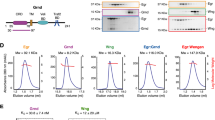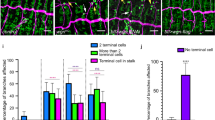Abstract
Argos, the inhibitor of the Drosophila epidermal growth factor (EGF) receptor, remains the only known extracellular inhibitor of this family of receptors in any organism. The functional domain of Argos includes an atypical EGF domain and it is not clear whether it binds to the EGF receptor or if it acts via a distinct receptor to reduce Egfr activity indirectly. Here we present two lines of evidence that strongly suggest that Argos directly interacts with the EGF receptor. First, Argos is unable to inhibit a chimeric receptor that contains an extracellular domain from an unrelated RTK, indicating the need for the EGF receptor extracellular domain. Second, Argos can inhibit the Drosophila EGF receptor even when expressed in human cells, implying that no other Drosophila protein is necessary for inhibition. We also report that Argos and the Drosophila activating ligand, Spitz, can influence mammalian RTK activation, albeit in a cell-type specific manner. This includes the first evidence that Argos can inhibit signalling in mammalian cells, raising the possibility of engineering an effective human EGF receptor/ErbB antagonist.
This is a preview of subscription content, access via your institution
Access options
Subscribe to this journal
Receive 50 print issues and online access
$259.00 per year
only $5.18 per issue
Buy this article
- Purchase on Springer Link
- Instant access to full article PDF
Prices may be subject to local taxes which are calculated during checkout



Similar content being viewed by others
References
Casci T and Freeman M. . 1999 Cancer Metastasis Rev. 18: 181–201.
Freeman M. . 1996 Cell 87: 651–660.
Freeman M, Klämbt C, Goodman CS and Rubin GM. . 1992 Cell 69: 963–975.
Gabay L, Seger R and Shilo B-Z. . 1997 Science 277: 1103–1106.
Golembo M, Schweitzer R, Freeman M and Shilo B-Z. . 1996 Development 122: 223–230.
Howes R, Wasserman JD and Freeman M. . 1998 J. Biol. Chem. 273: 4275–4281.
Lohmeyer M, Mason S and Gullick WJ. . 1997 Int. J. Oncol. 10: 677–682.
Reichman-Fried M, Dickson B, Hafen E and Shilo B-Z. . 1994 Genes Dev. 8: 428–439.
Schweitzer R, Howes R, Smith R, Shilo B-Z and Freeman M. . 1995 Nature 376: 699–702.
Stemerdink C and Jacobs JR. . 1997 Development 124: 3787–3796.
van de Poll MLM, van Vugt MJH, Lenferink AEG and van Zoelen EJJ. . 1997 Biochem. 36: 7425–7431.
Acknowledgements
We thank Jonathan Wasserman for making the S2-TorDEgfr cells. J Vinós was partially supported by a Marie Curie Research Fellowship of the EU.
Author information
Authors and Affiliations
Rights and permissions
About this article
Cite this article
Vinós, J., Freeman, M. Evidence that Argos is an antagonistic ligand of the EGF receptor. Oncogene 19, 3560–3562 (2000). https://doi.org/10.1038/sj.onc.1203702
Received:
Revised:
Accepted:
Published:
Issue Date:
DOI: https://doi.org/10.1038/sj.onc.1203702
Keywords
This article is cited by
-
Notch signaling coordinates ommatidial rotation in the Drosophila eye via transcriptional regulation of the EGF-Receptor ligand Argos
Scientific Reports (2019)
-
Regulatory mechanisms of EGFR signalling during Drosophila eye development
Cellular and Molecular Life Sciences (2016)
-
Negative regulation of ErbB family receptor tyrosine kinases
British Journal of Cancer (2004)
-
Argos inhibits epidermal growth factor receptor signalling by ligand sequestration
Nature (2004)



